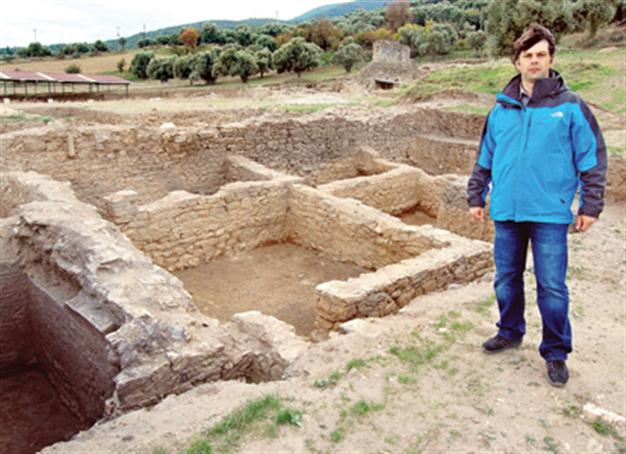Roman bath revealed in İzmir
İZMİR - Anatolia News Agency

A still-undeciphered seal written in hieroglyphics similar to those of the Hittites has also been found at Metropolis’ acropolis. AA photo
Recent archaeological excavations in İzmir’s ancient city of Metropolis have led to the discovery of a Roman bath featuring a sculpture of the goddess of luck Thyke and a sculpture of Zeus. The excavations also revealed gladiator figures.
Metropolis, which is located between the villages of Yeniköy and Özbek, is the site of many excavations because of its ancient ruins.
Excavation work has been continuing for 20 years with the support of the Culture and Tourism Ministry, the Sabancı Foundation, the Metropolis Foundation and Torbalı Municipality, Serdar Aybek, a scholar at Trakya University’s Archaeology Department and the Metropolis excavation president, told Anatolia news agency.
Aybek said there were many cultural aspects in Metropolis that belong to the Geometric period and Hellenistic times. Metropolis was a city of art, according to Aybek.
“Metropolis has a 5,000-year-old history, and it was situated during the early Bronze Age,” Aybek said, and excavations have revealed some ceramic pieces from the early Bronze Age and middle Bronze Age.
During the excavations, archaeologists also found accessories from the Hittite era. Metropolis was situated near the ancient city of Ephesus and all the buildings and sculptures in the city were made with perfection, Aybek said. “Metropolis is a Hellenistic ancient city.”
Ancient Greeks believed Artemis protected the city, he said. “This is something that we have never seen in the Anatolian ancient cities and this makes the Metropolis ancient city even more mysterious,” Aybek said.
During four months of excavations archaeologists unearthed a Roman bath in Metropolis.
“This year we have discovered new buildings in Metropolis,” said Aybek, adding that one of these structures was a 100-square-meter Roman bath.
The bath is covered with mosaics and is rectangular, Aybek said, adding that it included a sports area.
“The new Roman bath unearthed this year is smaller than the other baths in Metropolis,” Aybek said. “Next year, we will focus on these areas.”
The sculptures of Zeus and Thyke were discovered in the bath, which is thought to have been built in the second century B.C. by the Emperor Antininus Pius, Aybek said.
The ancient city of Metropolis was first investigated through archaeological field work in 1972 by Professor Recep Meriç from the Dokuz Eylül University, Izmir. Excavations on the site, which feature Classical, Hellenistic, Roman, Byzantine and Ottoman traces, began in 1989. The earliest known settlement at the site is from the Neolithic Age, showing evidence of contact and influence with the Troy I littoral culture.
A still-undeciphered seal written in hieroglyphics similar to those of the Hittites has also been found Metropolis’ acropolis. The Hittite kingdom of Arzawa had its capital Apasas (later Ephesus) roughly 30 kilometers to the southwest.
Metropolis was a part of the Hellenistic kingdom of Pergamum, and during this period the city reached a zenith of cultural and economic life. A temple dedicated to the war god Ares, one of only two known such temples, was also located here
















